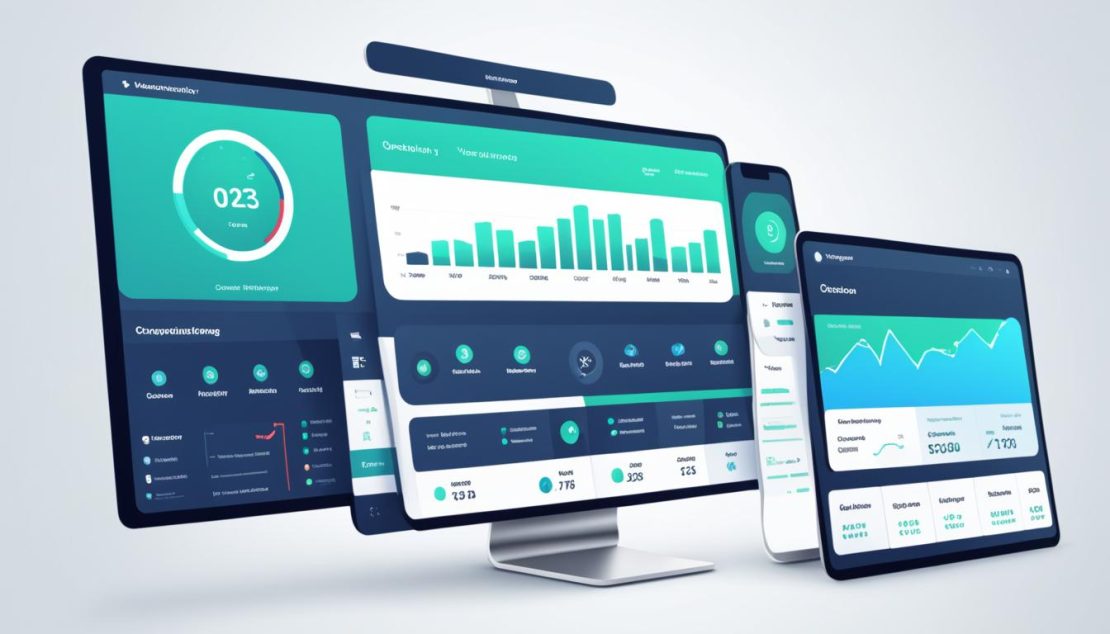In an era where the internet has become a cornerstone of daily life, virtual marketing strategies have emerged as the lifeblood of contemporary business growth. Cutting through the noise of an ever-expanding online marketing landscape, businesses are turning to ingenious digital marketing trends to capture attention, establish their brand presence, and drive consumer engagement.
In the pursuit of success, internet advertising plays a pivotal role, leveraging the digital domain to create meaningful interactions and forge lasting connections with audiences across the globe. As we delve into the fabric of what constitutes effective virtual marketing, we uncover the nuances that make it an indispensable tool for businesses today.
Stay tuned as we explore the essence of virtual marketing, digging into its fundamental principle, and uncovering the tactics that distinguish it from the traditional marketing playbook. Join us on this journey to decode the digital prosperity that virtual marketing promises.
Understanding Virtual Marketing: The Basics
Embarking on the digital journey, virtual marketing emerges as a dominant force in the realm of promotion and advertising. It represents a paradigm shift that paves the way for innovative customer engagement and robust digital customer experiences. Advancing from the static frameworks of yesteryear, today’s businesses require an acute sense of interactive marketing expertise and cross-channel marketing savviness to thrive in an increasingly virtual marketplace.
The Definition of Virtual Marketing
Virtual marketing is not merely a concept but a comprehensive approach, leveraging an array of digital channels to foster business-consumer interactions. This technique epitomizes the art of virtual advertising, where the digital customer experience is paramount, and every online touchpoint is an opportunity for engagement.
Evolution from Traditional Marketing Tactics
The evolution from traditional, in-person strategies to a virtual marketing framework symbolizes the transformative impact of technology on consumer behavior. Businesses now prioritize digital landscapes, crafting campaigns that harmonize with the daily digital routines of their intended audiences.
Key Components of a Virtual Marketing Strategy
A robust virtual marketing strategy is not monolithic but consists of diverse and interconnected elements. To dissect these components, we turn to a visual breakdown that underscores the integral aspects of a modern virtual marketing strategy.
| Component | Function | Impact on Marketing |
|---|---|---|
| Targeting & Segmentation | Identify and categorize the audience based on specific criteria. | Enhances relevance and precision in outreach efforts. |
| Content Generation | Creation of valuable, informative, and engaging content. | Drives engagement and fosters brand loyalty. |
| SEO | Optimization for search engines to improve visibility. | Increases organic reach and drives website traffic. |
| Data Analysis | Examination of performance metrics and customer data. | Guides strategy adjustments and decision-making. |
From the initial touchpoint to the final transaction, virtual marketing interweaves these core elements to create an immersive and interactive marketing experience that is both dynamic and results-oriented.
The Benefits of Implementing Virtual Marketing
The landscape of marketing has evolved dramatically with the advent of digital technology. Virtual marketing leverages this tech advancement to provide a plethora of benefits that can redefine how businesses connect with their audience. Below are several key advantages that virtual marketing offers, driving businesses towards its adoption for sustainable growth and increased market influence.

- Increased Brand Awareness: By utilizing platforms with a vast user base, businesses are able to amplify their visibility exponentially, ensuring that more potential customers are aware of their brand.
- Cost-Effective Marketing: Compared to the hefty expenses of traditional advertising, virtual marketing presents more budget-friendly avenues for promoting products and services.
- Targeted Advertising: The ability to dissect large demographics into targeted groups allows for more effective and personalized advertising strategies.
- Global Reach: With no geographical limitations, virtual marketing enables brands to traverse borders and reach an international audience with ease.
- Real-Time Analytics: Immediate access to campaign performance metrics empowers businesses to make data-driven decisions rapidly.
- Customer Engagement: Digital platforms facilitate a two-way conversation between brands and customers, fostering a deeper level of engagement and loyalty.
Companies implementing virtual marketing methodologies find that these benefits contribute significantly not only to the acquisition of new customers but also to the cultivation of a robust, active community around their brand. The table below offers an insight into how virtual marketing stands in stark contrast to traditional methods.
| Aspect | Traditional Marketing | Virtual Marketing |
|---|---|---|
| Audience Reach | Limited to local or regional | Unlimited, with a global audience |
| ROI Measurement | Challenging and often delayed | Immediate with real-time analytics |
| Cost Efficiency | Often expensive with high overheads | More affordable with various scalable options |
| Customer Interaction | One-way communication | Interactive and engaging |
| Ad Customization | Generic and broad | Highly personalized and targeted |
| Strategy Adjustment | Slow and rigid | Agile and adaptable |
In summary, virtual marketing is not just an alternative to conventional methods; it is a pivotal upgrade that aligns with contemporary consumer behavior and digital consumption patterns. Embracing virtual marketing is not merely an option for growth-oriented businesses, but a necessary step into the future of customer interaction and brand development.
Essential Tools and Platforms for Virtual Marketing Success
In today’s digital-first landscape, virtual marketing has risen to the forefront of strategic business initiatives. The advent of sophisticated tools and platforms has reinforced the importance of harnessing technology to cultivate and maintain a competitive edge. In this section, we explore the software and analytical instruments vital to executing a prolific virtual marketing strategy.
Software Solutions for Automation
Marketing automation tools have revolutionized the way we approach lead nurturing and customer engagement. By automating repetitive tasks, businesses can direct more attention to creativity and human-centric strategy. Tools like HubSpot, Marketo, and Salesforce are at the forefront of customer relationship management, offering an array of features that aid in efficiently tracking and managing customer interactions.
Analytical Tools for Measuring Performance
Performance metrics provide the benchmarks needed to evaluate the success of marketing endeavors. Analytical tools such as Google Analytics and Adobe Analytics offer deep insights into user behavior, campaign performance, and website engagement. Through these tools, marketers can measure and analyze a broad spectrum of data, from click-through rates to time spent on page, enabling informed decision-making and optimization of marketing efforts.
Engagement Platforms and Social Media
Engagement platforms and social media analytics tools like Hootsuite, Sprout Social, or Buffer play a critical role in deciphering the effectiveness of social campaigns and understanding audience preferences. By leveraging these platforms, brands can foster genuine connections with their audience, engage in real-time interactions, and track the social media metrics that matter most.

- Lead generation software such as Leadfeeder and OptinMonster enhances the capability to capture and convert potential customers, refining the quality of leads entering the sales funnel.
- Customer engagement platforms like Intercom and Drift provide sophisticated chatbot services and personalized messaging options to improve customer service and support.
Collectively, these tools and platforms furnish marketers with a comprehensive arsenal to execute, measure, and refine virtual marketing strategies. By understanding and utilizing these essential instruments, businesses can ensure their virtual marketing tactics are not only successful but also innovative and sustainable.
Best Practices in Virtual Marketing
In the dynamic world of virtual marketing, there are several best practices that businesses must embrace to not just survive but thrive. The key lies in engaging content creation — the cornerstone of any successful virtual marketing strategy. High-quality, relevant content is what attracts and retains your audience, turning casual browsers into loyal customers. It’s through compelling storytelling, informative blog posts, and interactive media that brands can form a meaningful connection with individuals, driving both engagement and conversions.
Building a reputation as a trustworthy brand also hinges on ethical marketing practices. This involves being transparent with your audience, respecting user privacy, and avoiding misleading advertising. In tandem, incorporating personalization techniques into your strategy can significantly enhance the customer experience. By tailoring content and offers to individual preferences, gleaned from data and behavioral insights, companies can make each interaction feel unique and personalized, significantly boosting customer satisfaction.
Moreover, achieving a consistent brand identity across all channels is critical. This practice, often referred to as omnichannel marketing, ensures that whether a customer encounters your brand through social media, email, or your website, they receive a seamless experience. Coupled with brand consistency—from your visuals to your messaging—this approach cements your image in the public consciousness, fostering recognition and loyalty. Embracing these best practices is not just about making a sale today; it’s about building the foundation for lasting success in the virtual marketplace.

